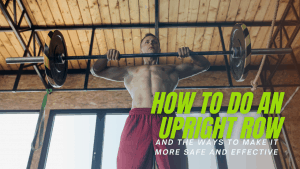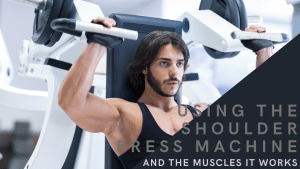What is a military press and its benefits
It is believed that the military press is called that way because the movement used to be a test of strength in the military. And if you think the exercise sounds tough, that’s because it is.
The military press is not considered advanced for no reason. But even though it is challenging, that doesn’t mean it is impossible to do. And while it is difficult, it can also be rewarding—if done properly.
So be at ease soldier, and keep scrolling to get started.
What is a military press?
The military press is an advanced variation of the overhead press. Their movement is similar since both require you to lift a bar or a pair of dumbbells overhead, but what makes the military press different is the position of the feet. In this exercise, you must bring your feet together like a soldier would at attention.
While the wide stance employed during an overhead press provides more support, the narrow stance in a military press removes that but replaces it with more core activation to stabilize your body.
The muscles at work during a military press
Deltoids
The main target of the military press is the deltoids, and the good thing about this exercise is that compared to most shoulder workouts that only engage one or two heads of the deltoid, the military press activates all three—the anterior, medial, and posterior deltoids.
During this exercise, the anterior and medial deltoids are recruited when you press overhead while the posterior deltoid is involved in the lock-out at the top of the movement.
Triceps
The triceps, located at the bottom of your arm opposite the biceps, are responsible for elbow extension which is the primary movement in a military press. Many studies have shown that performing the military press and other overhead press variations while standing is better at activating the triceps than performing them while seated. This means that the military press is one of the most ideal exercises for developing the triceps.
Pecs
Your chest muscles are also active during a military press, specifically the upper part. The clavicular head, which is the upper region of the pectoralis major, is engaged during the lifting portion to assist your shoulders as you press overhead.
Core
While it is not very obvious, your core is also at work during a military press. The abdominal muscles play an important role in stabilizing your body throughout the movement so you must engage them at all times, especially the rectus abdominis and the obliques, to prevent yourself from getting off balance and leaning too far forward.
How to do a military press
1. Start the exercise by adjusting the bar on the rack to just below your shoulders and loading the bar with just the right weight.
2. Position your feet close to each other, then grab the bar with a shoulder-width apart overhand grip.
3. Go under the bar then take it off the rack while maintaining a neutral back position.
4. Take a few steps backward then breathe in as you brace your core before pressing the bar overhead.
5. Once the bar is locked out at the top of the movement, breathe out then slowly lower the bar to your chest to return to the starting position.
6. Repeat according to your desired number of reps.
Tips for a more effective military press
• Tensing your quads, tightening your glutes, and planting your feet firmly on the ground provide stability in your lower body, putting you in a fixed position that allows you to lift better and heavier.
• Take a few deep breaths before the exercise to stabilize your rib cage and shoulders.
• Avoid a grip that is too wide. Ideally, your hands should only be shoulder-width apart on the bar. Going wider than that will make it difficult for you to comfortably lock your arms out at the top.
• Keep your forearms straight throughout the exercise to maintain balance and avoid transferring the load onto your elbows.
• Avoid bringing the bar too low to prevent excessive internal rotation of the shoulders. Lowering it too much will also make the exercise less effective in working the deltoids, so only take the bar down to your chin if you want optimal results.
The benefits of doing a military press
Stronger shoulders
Being a shoulder-centric exercise, it is no surprise that the biggest benefit of properly and consistently doing the military press is stronger shoulders. Since it offers an efficient range of motion, the military press is relatively safer for the shoulder joints than most shoulder exercises. As a result, you get a more flexible scapula that improves overall shoulder health which is extremely beneficial for doing pull-ups and other upper body strengthening exercises.
Constant core engagement
The positioning of your feet in a narrow stance makes balancing a struggle and forces you to recruit your abdominal muscles at all times because if you fail to do so, you getting off balance and falling over to either side is highly likely. The core muscles, specifically the rectus abdominis and obliques, work harder during a military press to make sure that your upper body is stable and upright throughout the exercise. With this constant tension on your core, the military press can be an incredible way to build core strength.
Improves body imbalances
The military press is also a pushing exercise so doing it will not only build but also improve the balance of your shoulders and triceps. Everyone has a dominant side and normally this side is almost always noticeably stronger. While it is not necessarily a bad thing, doing any press variations with such observable imbalance can be problematic at times. The good thing is, this can be corrected by doing exercises such as the military press because it requires both your arms to move synchronously to lift the barbell.
As you consistently perform the military press and increase the weight you are using, this one-sided dominance will gradually subside and what was initially your weaker side will eventually catch up until both your arms are equally strong.
Builds overall strength
Just like the back squat and deadlift, the military press is also a functional exercise. This means that it has movements that mirror day-to-day activities which can challenge you both inside and outside the gym. And since the motion is similar to mundane tasks that you do daily, strengthening your shoulders by doing a military press will make performing these chores much easier. Who doesn’t want carrying and pushing heavy objects to be effortless, right?
Military press mistakes to avoid
Weak and wide grip
While the activation and engagement of both the lower and upper body muscles are crucial during a military press, the strength and width of your grip are other critical aspects that should not be overlooked. With a firm, shoulder-width grip, you can easily and flawlessly press heavier weights overhead and. Moreover, this kind of grip also stabilizes your forearms to effectively keep your shoulders locked out at the top of the movement.
Overly bent wrists
Now that you know to keep a strong grip on the bar at all times to fully activate your forearms and biceps, you must also remember not to flex your wrists too much. Instead, hold the barbell in front of your shoulders as close to the neck as possible, with the back of your wrists in line with your forearms. This position will force you to bring your elbows slightly forward to create a stable surface for the barbell to sit on rather than slide down onto the upper chest.
Flared out elbows
Your elbows flaring out places unnecessary stress on your shoulder and elbow joints which can impact how effective a military press will be. This usually happens because of weak triceps and unstable back. If you find your elbows flaring out too much when you do the military press, correct it immediately by making sure that your elbows remain angled into the body to allow your shoulders, triceps, and upper chest to press the weight overhead. Failure to do this will result in less engagement and activation of the deltoids, triceps, and clavicular head of the pectoralis major.
Overarching the lower back
Arching your back too much, regardless of the exercise, will never bring any positive results. Not only is this improper form, but it also puts your lumbar spine in a dangerous position that can result in long-term back injuries. An arched back is usually caused by a weak core, tight gluteal muscles, and ignorance of what correct spinal alignment feels like under load. Aside from that, many people tend to arch their back excessively to make the line of force more horizontal, making the military press look more like a standing incline bench press instead. While this enables you to lift heavier weights by relying on your chest, it can also seriously damage your spine along the way.


